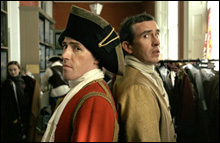 Michael Winterbottom’s adaptation of Laurence Sterne’s monumental ode to digression itself begins with a digression about actor Rob Brydon’s teeth. He’s being made up for a scene as Uncle Toby in a film version of Tristram Shandy directed by Michael Winterbottom. Next to him sits Steve Coogan, who’s being made up for the title role. (He also plays Tristram’s father, Walter.) What color are Brydon’s teeth, exactly? “Pub-ceiling yellow,” Coogan suggests.
Michael Winterbottom’s adaptation of Laurence Sterne’s monumental ode to digression itself begins with a digression about actor Rob Brydon’s teeth. He’s being made up for a scene as Uncle Toby in a film version of Tristram Shandy directed by Michael Winterbottom. Next to him sits Steve Coogan, who’s being made up for the title role. (He also plays Tristram’s father, Walter.) What color are Brydon’s teeth, exactly? “Pub-ceiling yellow,” Coogan suggests.
In other words, when it comes to indirection, self-consciousness, reflexivity, and sheer anarchic whimsy, Winterbottom’s adaptation holds its own against the original. And to modern tastes at any rate, it’s a lot funnier.
Sterne began writing his magnum opus around 1759 and finished it in 1768. At least, that’s when he stopped writing it, because he died. More than a demonstration of storytelling as a way of delaying the inevitability of death, Shandy barely gets around to the title narrator’s moment of birth, dancing around that and other terrors like the fear of castration and the void of identity with 500 pages or so of sidetracks, including a chapter on whiskers, a chapter on buttonholes, and a chapter on chapters.
All of interest only to graduate students, perhaps, but Winterbottom makes light work of Sterne’s labyrinthine wanderings, and his film within a film suggests what Christopher Guest might have come up with had he done the adaptation of John Fowles’s The French Lieutenant’s Woman. Delightful and accessible, it nonetheless holds up a funhouse mirror to the original’s anxieties. Thus “Steve Coogan” sees his own life assaulted and his ego punctured as the “moviemakers” depict the crises of Tristram’s existence, including a brilliantly comic moment of conception, a brutal birth, a botched christening, and a painful incident with a window sash. At the same time, Coogan senses that the role of genial Uncle Toby, whose own hobby horse involves erecting a model of the battlefield where he may or may not have lost his manhood, a role played by the unassuming and sneaky “Rob Brydon,” might be squeezing him out of the story of his life. His fear culminates in a literal in utero fantasy scene that captures the horror and the hilarity at the heart of Sterne’s conception.
Winterbottom’s playfulness extends to his own eclectic, prolific output — at one point “Coogan,” who has dirty laundry to hide from the press, agrees to an on-set interview with a smarmy reporter played by Tony Wilson, the real-life character Coogan played in Winterbottom’s 24 Hour Party People (2002). This assault on straightforward narrative can make you giddy, but it’s all in good fun, and as such Shandy may be the most successful adaptation of a literary work ever. Someone described Sterne as a postmodernist who came before there was a modern to post, and Winterbottom almost catches up with the arch procrastinator’s rollicking art of slowing things down.